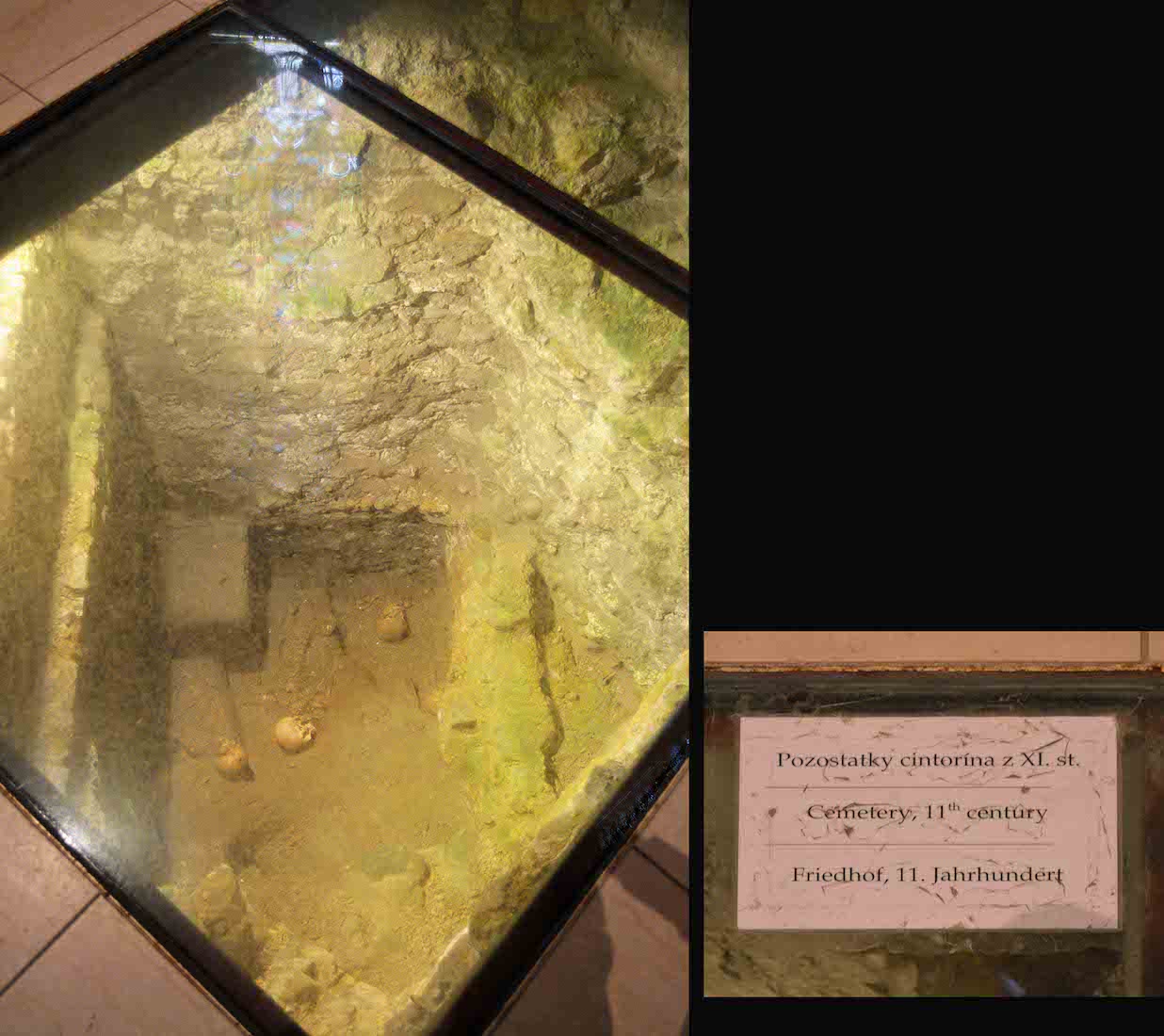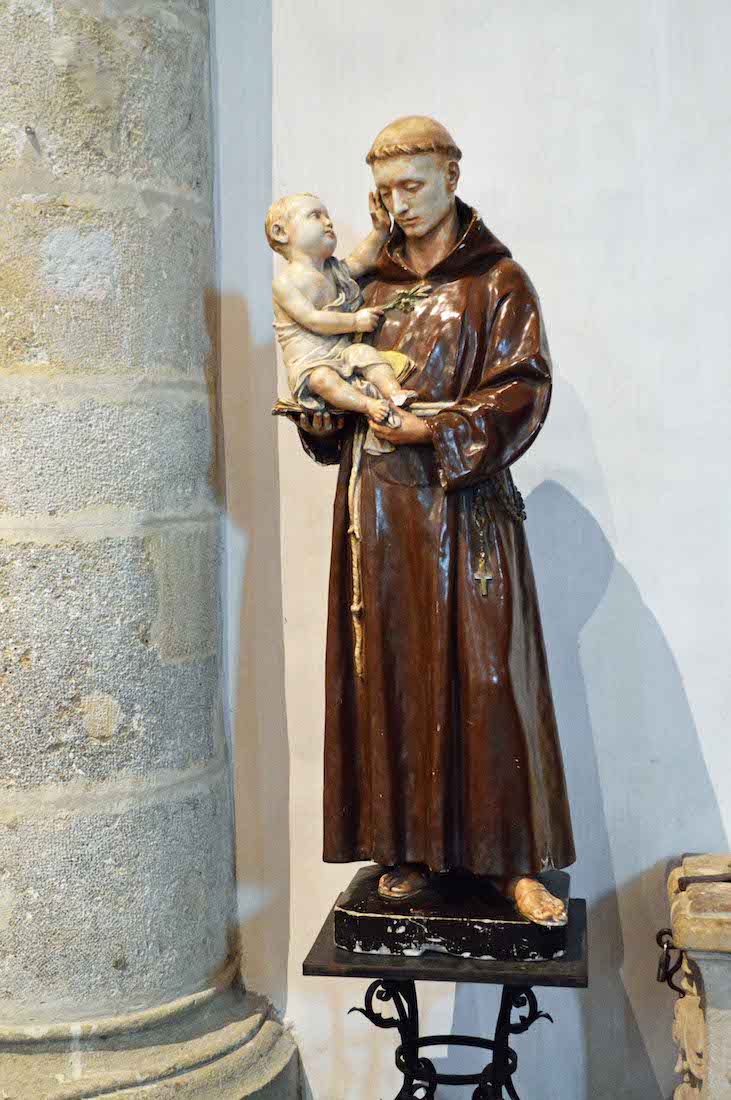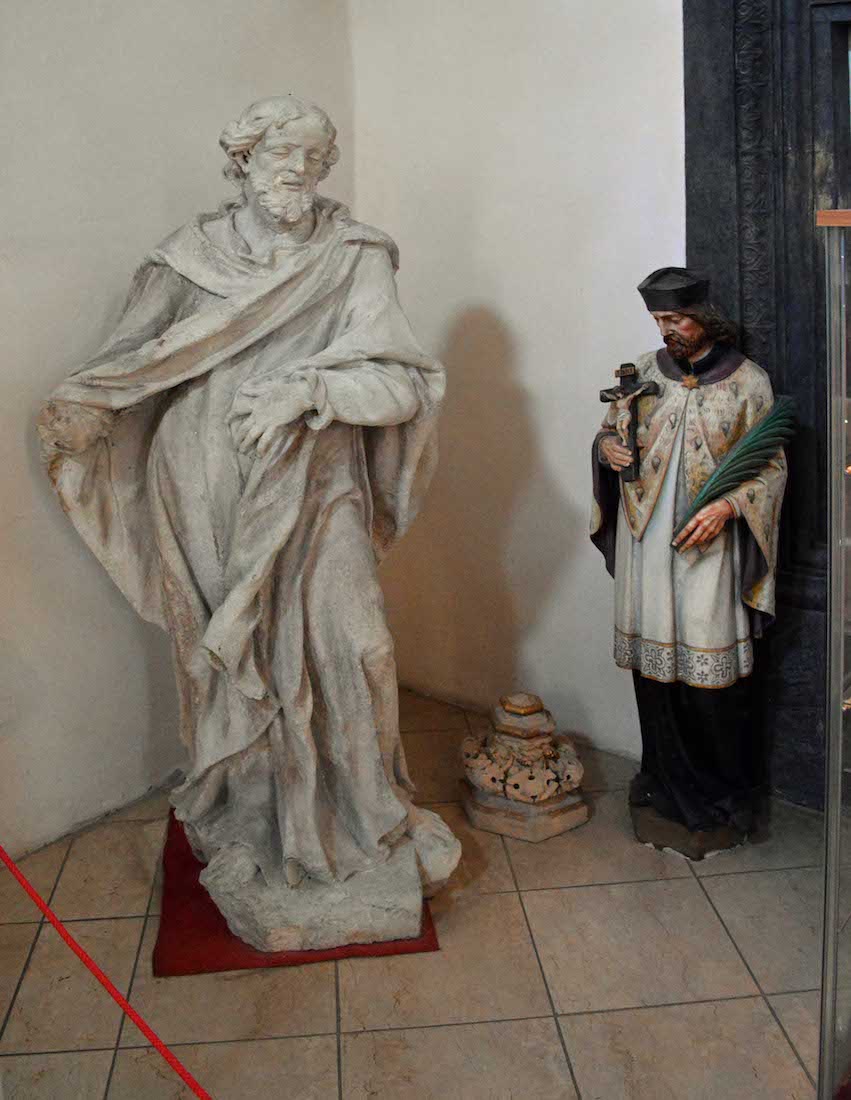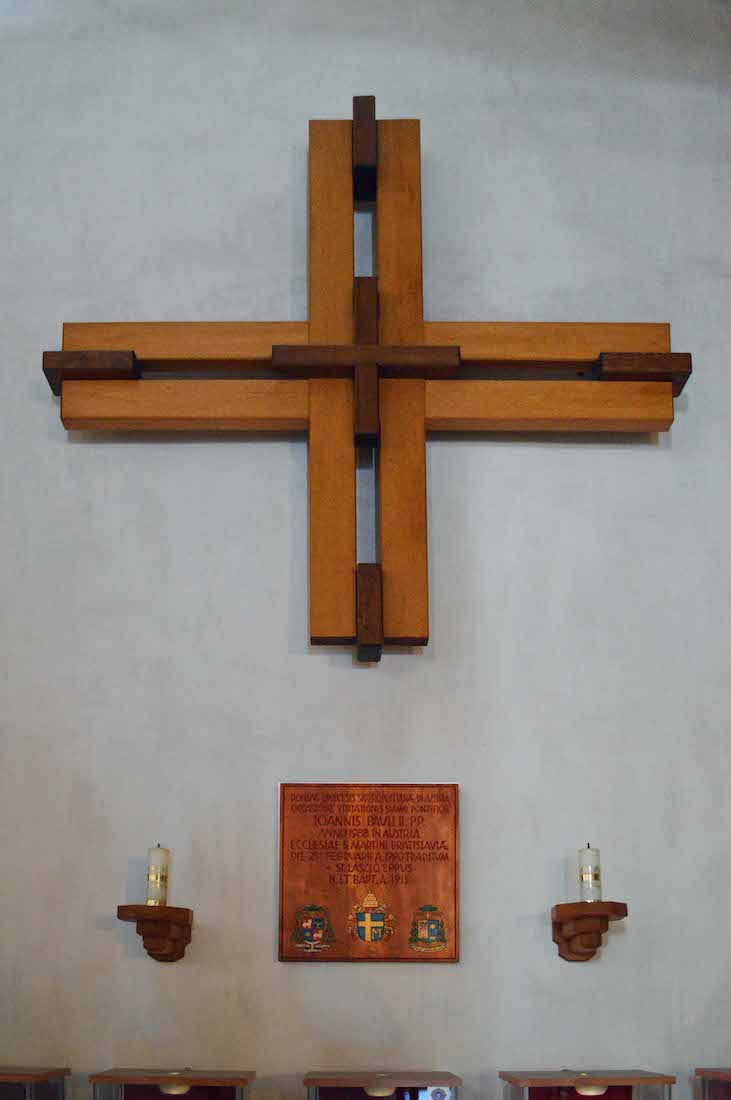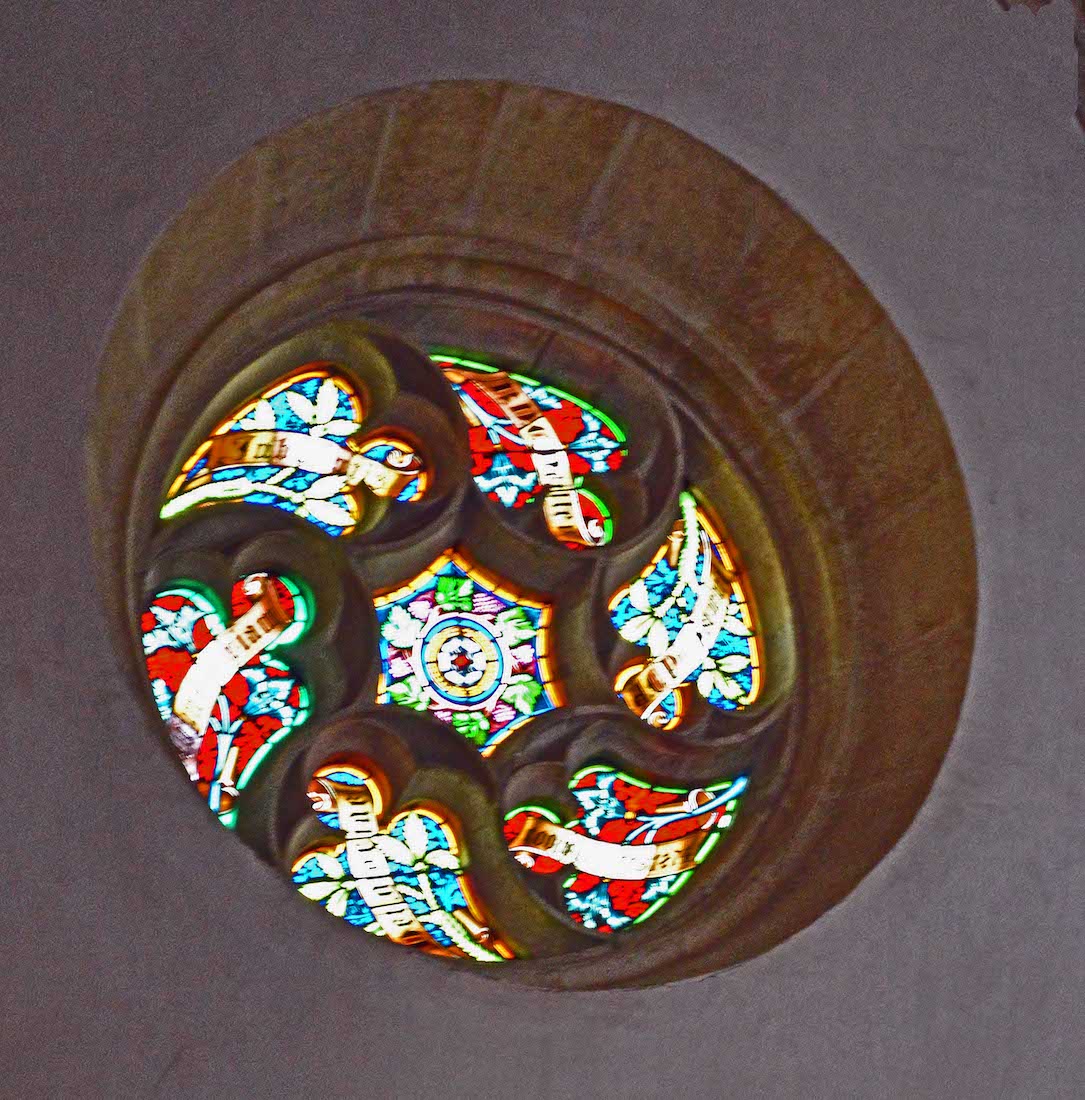
In the South East corner of the nave is this example of Baroque visual art admired by thousands of visitors – the equestrian statue of St. Martin dividing his cloak to share it with a beggar. The statue was created by Juraj Rafael Donner in 1735. The face of St. Martin resembles that of Archbishop Imrich Esterházy. INDEX
62. SOUTH NAVE WINDOW

This is an interesting window. At the top of the scene is God the Father and a descending dove indicating the Holy Spirit. At left is the Risen Christ as the Lily of the Valley. At right, the Virgin Mary holds a chalice. And at centre a monk’s cell with an open window, suggesting ... ?
63. EXCAVATION
In the floor of the South East corner of the nave, the excavation of an old cemetery – complete with bones – is revealed. The notice claims that this dates from the 11th century.
64. ALTAR OF OUR LADY OF SORROWS
The Altar of Our Lady of Sorrows has at centre the ‘pieta’ statue of Mary holding the body of Jesus. Below is a tabernacle and scenes from the life of Christ. Various other female saints are pictured, including St Ceclia, the patron saint of music. The altar was made by F. Prinoth of St Ulrich.
65. ST ANTHONY
Just West of the altar is a statue of Saint Anthony of Padua (1195 – 1231), also known as Anthony of Lisbon. He was a Portuguese Catholic priest and friar of the Franciscan Order. He has an interesting life story, and today is often recognized as the patron saint of finding things. There is a legend that toward the end of his life Anthony spent time praying in a hermit cell. One night, his little cell suddenly filled up with light, and Jesus appeared to Anthony in the form of a tiny child.
66. SOUTH NAVE WINDOW
And nearby is this next window, depicting St Peter at left holding the Keys of the Kingdom, and St Paul at right with his sword at the ready.
68. SOUTH PORTAL WINDOW
The three light window above the portal door shows Christ at the centre with the inscription ‘Saviour of the World’. The lights on either side have the verses from Matthew 22:37–40 : “ ‘Love the Lord your God with all your heart and with all your soul and with all your mind.’ This is the first and greatest commandment. And the second is like it: ‘Love your neighbour as yourself.’ All the Law and the Prophets hang on these two commandments.”
69. PORTAL DISPLAY
The Southern portal contains displays of various old and precious cathedral objects.
70. PORTAL SCULPTURES
These two unidentified sculptures stand in the corner of the South portal.
71. PORTAL DISPLAY
It would be useful to be able to read Slovakian! Objects on display here include a stoup, candlesticks, a crucifix, and a crown.
72. SOUTH WEST NAVE
Leaving the Southern portal, we re-enter the nave and continue our circuit. Of interest before us are three more windows, a tapestry, and a cross with a display below.
73. TAPESTRY
This tapestry of St Cyril and St Methodius was designed by Nicholas Klimčák. Saints Cyril and Methodius were 9th century Byzantine Greek brothers born in Thessalonica, Macedonia, who became Christian missionaries among the Slavic peoples of the Great Moravia and Pannonia. Through their work they influenced the cultural development of all Slavs, for which they received the title ‘Apostles to the Slavs’. They are credited with devising the Glagolitic alphabet, the first alphabet used to transcribe Old Church Slavonic.
74. SOUTH NAVE WINDOWS
These are the final two ‘long’ windows of the South nave. The left window features St Carolus Boromá, (Charles Borromeo) (1538–1584) who was a cardinal and archbishop of Milan from 1564 to 1584. The right window depicts St Carisia – perhaps St Carrisima, who was a French nun of the 5th century?
75. SOUTH NAVE DISPLAY
At the West end of the South nave is this impressive display of cathedral treasures.
76. MISSIONARY CROSS
This missionary equilateral cross was mounted on the South wall on Feb. 25, 1990, following a visit to Vienna, by Pope John Paul II. The board below gives an inscription in Latin and bears the Papal coat of arms.
77. ROUND WINDOW
Our final Cathedral window is this round window in the South nave wall. It has an hexagonal symmetry, and appears to depict various (illegible) texts.
78. ORGAN
This brings us to the West nave wall. The 19th century organ is placed high against the West wall in its own loft. It has been tied to the names of Liszt and Bartok, but there are moves to have it relocated and replaced with a more modern instrument.
79. WEST WALL AND CLOCK
Ah ... here is that clock! – sheltering beneath the organ loft. And there is a doorway beneath the clock ... how did I miss this?
80. ARCHBISHOP’S CREST
On the floor near the clock is displayed this coat of arms of Ján Sokol (archbishop of Bratislava-Trnava, archbishop of Trnava). This completes our tour of St Martin’s Cathedral.

CONCLUSION
I am happy to receive constructive comments or corrections concerning this website. The best websites are the ones which have no errors! I am grateful to my wife Margie who came to St Martin’s with me, and who has proof-read these pages. My thanks also to Alexandru Ciobanu for permission to use his great photo of the chancel ceiling.
The text on this site relies heavily on my interpretation of the Google translated Slovakian text found on
http://dom.fara.sk/?q=dom/o_dome
– not an easy task!
In fact, our visit to St Martin’s was a rather unhappy comedy of errors. We arrived there without the required euros, and were refused entry by the immovable lady welcomer (guard?!). We were rescued by the unexpected kindness of an unknown fellow tourist who paid our entry fee. Without his generosity this site would not have been created. Then later, emerging from the crypt, I banged my head on a stone arch which meant I was staunching the blood flow for the rest of our visit! Finally, in my discombobulated state, passing the clock I failed to notice the opening beneath leading to the sacristy and area under the tower – so no photos! Perhaps this calls for a further visit to Bratislava?
My photographs which appear on this site can also be found in higher resolution at:
https://www.flickr.com/photos/paulscottinfo/albums/
Site created 11 / 2015 ; reformatted 01 / 2021
Paul Scott

